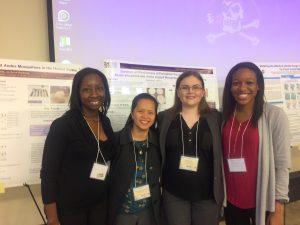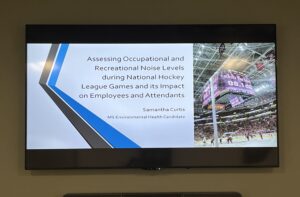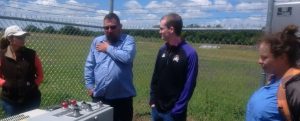By: Dr. Stephanie L. Richards, Principal Investigator, NC GlaxoSmithKline Foundation Grant
We have just completed the first cohort of a summer undergraduate research immersion program associated with the “Growing a Diverse Public Health Workforce” grant to East Carolina University (ECU) funded by the North Carolina GlaxoSmithKline Foundation (2022-2026). This summer’s cohort (2023) represents students from five universities: Fayetteville State University (FSU), North Carolina Central University (NCCU), Chowan University (CU), Winston-Salem State University (WSSU), and University of North Carolina at Pembroke. Twelve candidates were selected from 44 student applicants for participation in the STEM Summer Research Immersion Program at ECU conducted from June 1 to August 10, 2023. Students attended weekly professional development and networking activities and worked on a variety of research projects with ECU faculty mentors across campus from Departments of Biology, Biochemistry and Molecular Biology, Coastal Studies, Health Education and Promotion (Environmental Health program), Microbiology and Immunology, and Public Health. A research poster symposium was held on August 8, 2023 where all 12 NC GlaxoSmithKline Foundation summer research students presented the findings of their summer projects. Outcomes of the summer research immersion program include benefits such as increased participation in high-impact activities (research exposure), matching of undergraduate students with potential future graduate school mentors, building a sense of community among early career scholars, and fostering of social and professional networks that could result in increases in applications for (and matriculation into) health-related graduate programs. As each cohort of summer students graduates, they will be eligible and prioritized to receive graduate school scholarships (also funded by NC GlaxoSmithKline Foundation grant) if accepted into one of ECU’s health-related graduate programs supported by this grant (Master of Public Health, Master of Arts in Health Education, Master of Science in Environmental Health, and Master of Science in Biology).
The ECU Environmental Health program hosted two research students this summer: Kaya Peyton from North Carolina Central University (NCCU) (mentored by Dr. Stephanie Richards and Dr. Avian White) and KiHyira Jones from Fayetteville State University (FSU) (mentored by Dr. Jo Anne Balanay).

Abstract of Kaya Peyton
Title: Evaluation of wind tunnel for exposure of Aedes albopictus and Culex pipiens quinquefasciatus mosquitoes to Biomist®
Author List: Kaya Peyton, Avian White, Sinan Sousan, Will Murray and Stephanie Richards
Mosquitoes can develop resistance to insecticide active ingredients (Al) over time when exposed to sublethal doses. This is a public health risk as insecticides applied by mosquito control programs are one method for preventing mosquito-borne diseases. Mosquito exposure to insecticides during ultra-low volume (ULV) application occurs via direct liquid contact to formulated products (FP) while barrier applications expose mosquitoes to dried residual FP. The Centers for Disease Control and Prevention (CDC) bottle bioassay (contact with dried residual insecticide AI) may not directly relate to operational interventions for ULV applications. We developed a method for exposing mosquitoes to FP using a compact wind tunnel apparatus. Initial wind tunnel testing was conducted onan Aedes albopictus lab colony, Ae. albopictus field colony, and Culex pipiens quinquefasciatus field colony using a FP commonly used by mosquito control operators in North Carolina (Biomist® 3+15; AI permethrin). Female mosquitoes were aspirated from colony cages and transferred to cardboard cages (10-15 mosquitoes/cage; 3 replicate/cages/group) and exposed to Biomist® (1.6 mL/min for 5 s, 10 s, or 20 s). Control groups were exposed to air for the same exposure time in the wind tunnel. Immediately after exposure, mosquitoes from each group were chilled, transferred to separate cages, provided 20% sucrose and placed in a 28°C incubator. Mortality was monitored/recorded for all groups 15, 30, 60, 120 min and 24 h post exposure. T-tests (P < 0.05) showed significantly higher mortality rates in treatment compared to control groups in both the CDC bottle bioassay and wind tunnel experiments.



Abstract of KiHyira Jones
Title: Comparison of heat stress exposure of outdoor workers between concrete and grass surfaces
Authors: KiHyira Jones, Bridget Angol and Jo Anne Balanay
Heat stress is the net heat load to which a worker is exposed and to which physical exertion, environmental factors and clothing contribute to. Extreme heat exposure can cause heat-related illnesses (HRIs), including heat stroke. The heat stress of exposure of outdoor workers may be affected by several environmental factors, including the type of surface on which workers perform their tasks. The purpose of this study is to assess the heat stress exposure of outdoor workers in a university setting, with the specific aims of 1) comparing the heat stress exposure between concrete and grass surfaces and 2) comparing the heat stress exposure to the ACGIH Threshold Limit Value (TLV). We hypothesized that the concrete surface has a higher heat stress exposure on outdoor workers compared to that on a grass surface, with the assumption that the water evaporation occurring on grass will result to cooling in the surrounding area and the concrete will hold more heat that will increase the air temperature above the surface. Heat stress monitoring was conducted simultaneously in 2 monitoring locations (i.e., grass and concrete surfaces) using heat stress monitors. The dry bulb (°C), wet bulb (°C) and globe temperatures (°C), wet bulb globe temperature (WBGT) index (°C) and relative humidity (%) were recorded each monitoring day from 8am to 5pm for 15 summer days. Study findings showed that the heat stress exposure on grass and concrete surfaces, in terms of hourly mean, daily mean and daily maximum, are not significantly different (P≥0.41). However, the highest daily mean (31.04 ± 1.54°C) and maximum WBGT (34.21°C) was recorded on the grass surface and the lowest daily mean (22.38 ± 2.09°C) and maximum WBGT (25.00°C) was recorded on the concrete surface. Knowing the difference in heat stress exposures between different types of working surfaces will be beneficial in determining whether workers would need different preventive measures when they are working on concrete surfaces vs soil surfaces.







